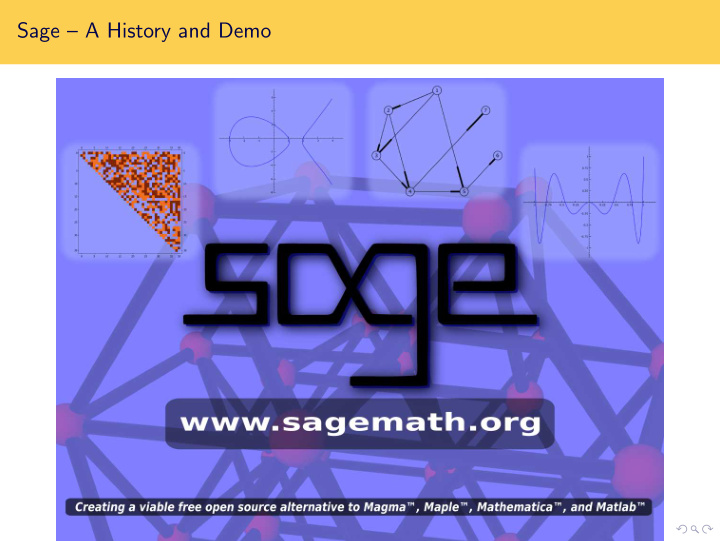



Sage – A History and Demo
History: Where did Sage Come From 1997–1999 ( Berkeley ) HECKE – C++ (modular forms) 1999–2005 ( Berkeley , Harvard ) I wrote over 25,000 lines of Magma code. Ad hoc languages and closed source devel models of Magma, Mathematica, Matlab, and Maple are old-fashioned and painful . I must see inside and change anything in my software in order to be the best in the world at my research. Feb 2005 I released SAGE-0.1 (over 3 years ago!) Feb 2006 UCSD SAGE Days 1 workshop – SAGE 1.0. October 2006 U Washington SAGE Days 2 workshop. March 2007 UCLA SAGE Days 3 workshop. May 2007 Sage NSF grant– funds Clemenet Pernet. June 2007 U Washington SAGE Days 4 workshop. October 2007 Clay Math Institute SAGE Days 5 workshop. November 2007 Heilbronn Institute SAGE Days 6 Feb,Mar 2008 IPAM Sage Days 7 ; Austin Sage Days 8 June 2008 Sage Devel Days at UW. Sage-3.0 was released yesterday!!
Nov 2007: Sage wins first place in Trophe´ es du Libre and gets slashdotted... Tons of articles all over resulted, about 10,000 downloads in a weekend, etc...
Sage: Mission Statement Sage: Mission Statement Provide a uniform open source high-quality viable alternative to Magma, Mathematica, Maple and MATLAB . When possible, do not reinvent the wheel but reuse existing building blocks , and make sure the resulting code is rigorously tested , easy to modify and very well documented . Also create a helpful environment and community (mailing lists, irc-channel, workshops, coding sprints). There are 430 subscribers to sage-support .
What is Sage? Sage is a very large mathematics software package developed by a worldwide community of over 50 developers. Sage is: 1 a distribution of the best free, open-source mathematics software available (Sage 2.11 ships about 70 packages) that is easy to compile or install from binaries. 2 a new library , filling in gaps in functionality so Sage covers a wide range of algebraic, scientific, and statistical computing. 3 interfaces to almost all existing mathematics software packages (including Magma, PARI, Gap, Matlab, Mathematica, Maple, etc.)
Who Funds and Supports Sage Development?
Who? 48 people contributed code that’s new in Sage-3.0! Tim Abbott, Michael Abshoff, Martin Albrecht, Nick Alexander, Tom Boothby, Robert Bradshaw, Jason Brandlow, Michael Brickenstein, Dan Bump, Craig Citro, Ondrej Certik, Timothy Clemans, John Cremona, Didier Deshommes, Nathan Dunfield, Dan Drake, Alexander Dreyer, Burin Erocal, Gary Furnish, Alex Ghitza, Andrzej Giniewicz, Jason Grout, Marshall Hampton, Mike Hansen, David Harvey, Geert Heldager Nielsen, David Joyner, Michael Kallweit, Josh Kantor, Simon King, Emily Kirkman, Robert Miller, Minh Nguyen, Willem Jan Palenstijn, Clement Pernet, Steffan Reidt, David Roe, Ryan Hinton, Anne Schilling, Harald Schilly, William Stein, Chris Swierczewski, Nicolas Thiery, Gonzalo Tornaria, John Voight, Yi Qiang, Justin Walker, Carl Witty These are people who contributed and had accepted (via a referee process) new code in the last three weeks.
Python Binds all things in Sage Together Python is a powerful modern interpreted programming language. “Python is fast enough for our site and allows us to produce maintainable features in record times , with a minimum of developers,” said Cuong Do, Software Architect, YouTube.com. “Google has made no secret of the fact they use Python a lot for a number of internal projects. Even knowing that, once I was an employee, I was amazed at how much Python code there actually is in the Google source code system .”, said Guido van Rossum, Google , creator of Python. “Python plays a key role in our production pipeline. Without it a project the size of Star Wars: Episode II would have been very difficult to pull off. From crowd rendering to batch processing to compositing, Python binds all things together ,” said Tommy Burnette, Senior Technical Director, Industrial Light & Magic.
Python & Cython: The Main Languages of Sage http://www.python.org and http://www.cython.org Python A mainstream language with millions of users. TIOBE declares Python as programming language of 2007! “Python has been declared as programming language of 2007. It was a close finish, but in the end Python appeared to have the largest increase in ratings in one year time (2.04%). There is no clear reason why Python made this huge jump in 2007. Last month Python surpassed Perl for the first time in history, which is an indication that Python has become the “de facto” glue language at system level. It is especially beloved by system administrators and build managers. Chances are high that Python’s star will rise further in 2008, thanks to the upcoming release of Python 3.” Cython : compiled Python – lead developer (Robert Bradshaw at UW) Growing and getting used in other projects... Cython is for some people definitely one of the main “killer features” of Sage over Magma.
A Powerful Web-based Graphical User Interface public notebooks available at http://www.sagenb.org graphical user interface plotting LaTeX typesetting remote access worksheet sharing interface to 3rd party systems, e.g. Magma
Demo Demo
Getting Started With Sage Web page: http://www.sagemath.org 1 Install Sage on your computer or sign up for an account at http://www.sagenb.org 2 Thousands of pages of documentation 3 Mailing lists 4 Course on Sage this quarter at UW with video online for each lecture and a book in progress: http://wiki.wstein.org/2008/480a Complete video online! 5 Sage Developer Days 8.5 in June (13-20)
Recommend
More recommend